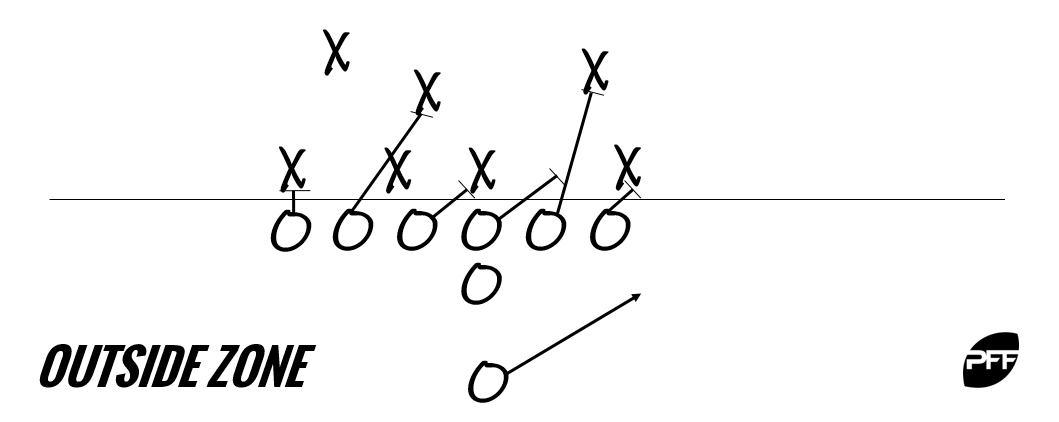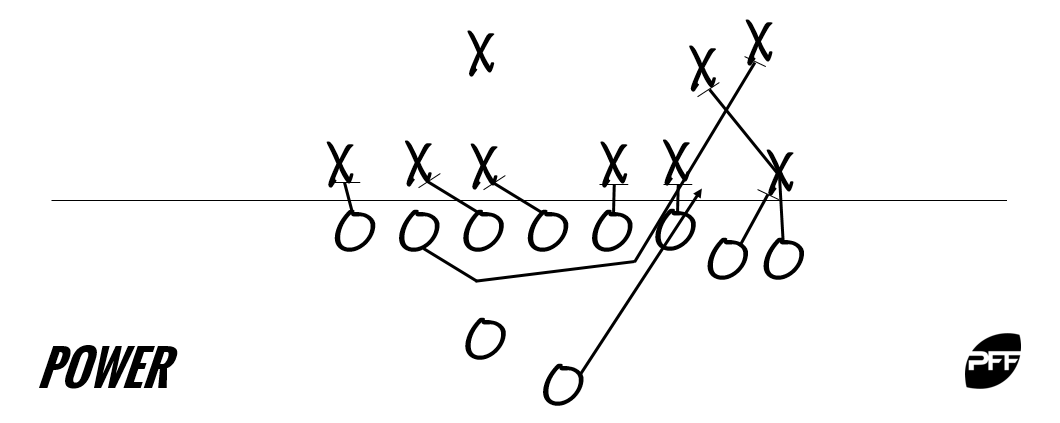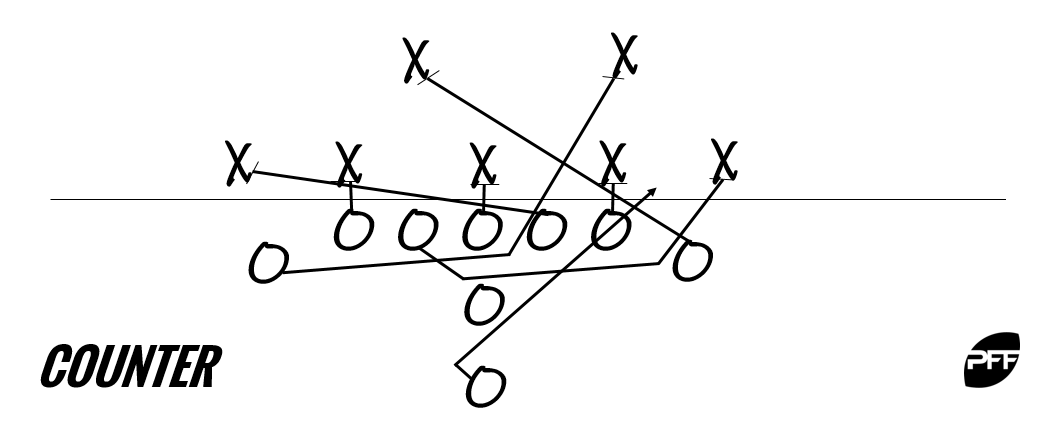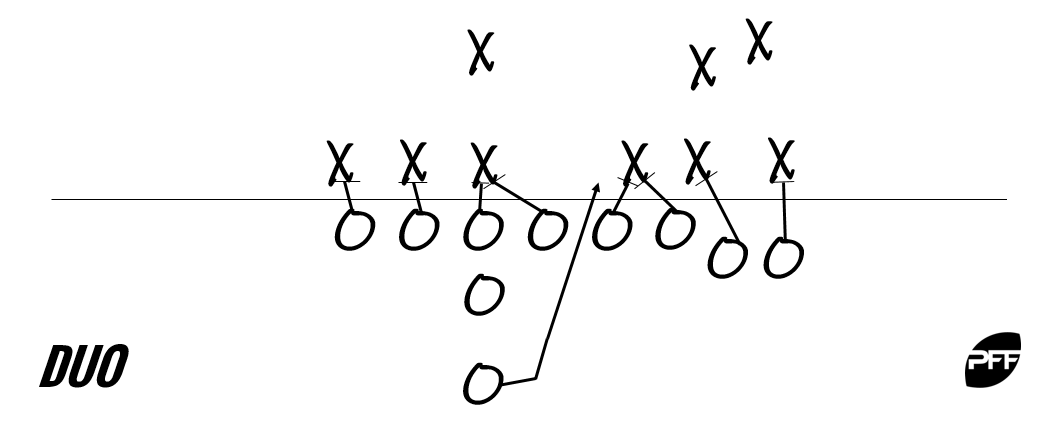At PFF, we capture the base run concept on every play, helping to add context to how a team’s running game truly attacks opposing defenses. While NFL teams have various names and techniques for each of their running plays, we capture the general concept on each play and that information has become a crucial piece of weekly game planning from our 32 NFL team customers. In addition to the basic concept, we have a variety of extra “tags” that add a layer of detail to capture what each core blocker is doing on the play.
Here’s a look at the various run concepts we track on a play-by-play basis.
[Editor's note: the play diagrams below are visual representations of actual plays that occurred during the 2017 season using PFF's proprietary data collection and play-drawing technology.]
Also known as a “stretch” play, the outside zone play is designed to get the defense moving laterally, challenge the edge of the run defense and hit the hole where the defense is at its weakest. The running back takes a wide track, looking to stretch the edge of the defense and he is generally reading the playside edge defender to determine whether or not he should continue his path or “cut back” against the grain as the interior of the defense is being moved laterally. Outside zone can and will hit anywhere, playside and backside, and it’s crucial that the running back read his keys decisively while relying on only one quick cut to his desired hole. Because the play can hit anywhere along the offensive line, back-side blocks are critical to ensure that there are holes for the running back to hit if he has to take the ball inside or even all the way to the back side of the play.
The inside zone is more of a downhill play compared to outside zone, and it will generally look for the running back to hit a hole in between the tackles, though many plays still hit outside the tackles due to the flow of the defense. Like the outside zone, there are multiple gaps in which the play can hit, though the running backs read the defensive tackles, rather than starting with the defensive end, to determine where to take the ball. Due to the angle in which the offensive line fires off the ball, the inside zone play will often “cut back” as offensive linemen look to create both vertical and horizontal displacement along the defensive front. Linemen must communicate effectively as their blocking assignment is heavily dependent on the defensive alignment, and they’ll look to double team, if possible, before finding their predetermined second-level assignment. Backside blocks are crucial on inside zone plays as the ball cuts back often.
In PFF terms, any play that features a single pulling offensive lineman from the backside of the play to the front side of the play is considered “power,” though there are certain versions of the play that will feature different terminology in every playbook. Power features a series of blocks on the front side of the play, looking to clear out the first level of the defense while a backside puller comes through to clean up the rest. Unlike zone plays, power plays have a predetermined point of attack and it’s more dependent on multiple clean blocks in order to give the running back room to operate. While the running back on a zone play is often reading the defense and making a quick, decisive cut, he must exhibit good patience when running power in order to allow his blocking to set up before running away from the leverage of the defense. Due to the blocks up front that take the defense in one specific direction, cutting back on power is generally not advised as the running back is often running right into the flow of the defense, despite holes that appear enticing when watching plays in slow motion. However, the cutback on power is a weapon when used against fast-flowing linebackers who are too quick to jump to their play-side gap. Back-side blocks are less important on power plays as the ball should stay on the front side and most backside defenders will be holding their ground in order to keep gap integrity.
Counter plays are very similar to power plays though in PFF’s definition, there is a second blocker coming from the backside to the playside. There is still a backside puller, however on counter, the puller will generally get to the hole first, while the fullback will get to the hole first on power. Much like power, the point of attack is predetermined and the front side blockers are looking to clear out the defensive line to give room for the puller and the running back to run through the hole.
Think double teams and vertical displacement as the offensive line is looking to create movement through multiple double teams while the running back takes the ball away from the middle linebacker. The edges of the defense will often collapse in this run concept, making room for a quick cut to the outside if the middle linebacker gets sucked inside or even slowed up by strong double teams up front. If the middle linebacker stays outside, the running back can jam the ball up the middle behind the double-team blocks.
It’s a trap! Just as it sounds in the name, trap plays are looking to catch a defender off guard, most often a down lineman who is looking to penetrate upfield. But allowing him to come free, often to his surprise, while using a pulling guard to wash him out of the play, offenses are able to get two offensive linemen to the second level cleanly. A well-executed trap is one of the prettiest plays in football, though it loses effectiveness if defenders have an idea that it could be coming. When used at the right time, it’s an easy way to create and open gap while giving the running back a clear path into the secondary.









 © 2025 PFF - all rights reserved.
© 2025 PFF - all rights reserved.